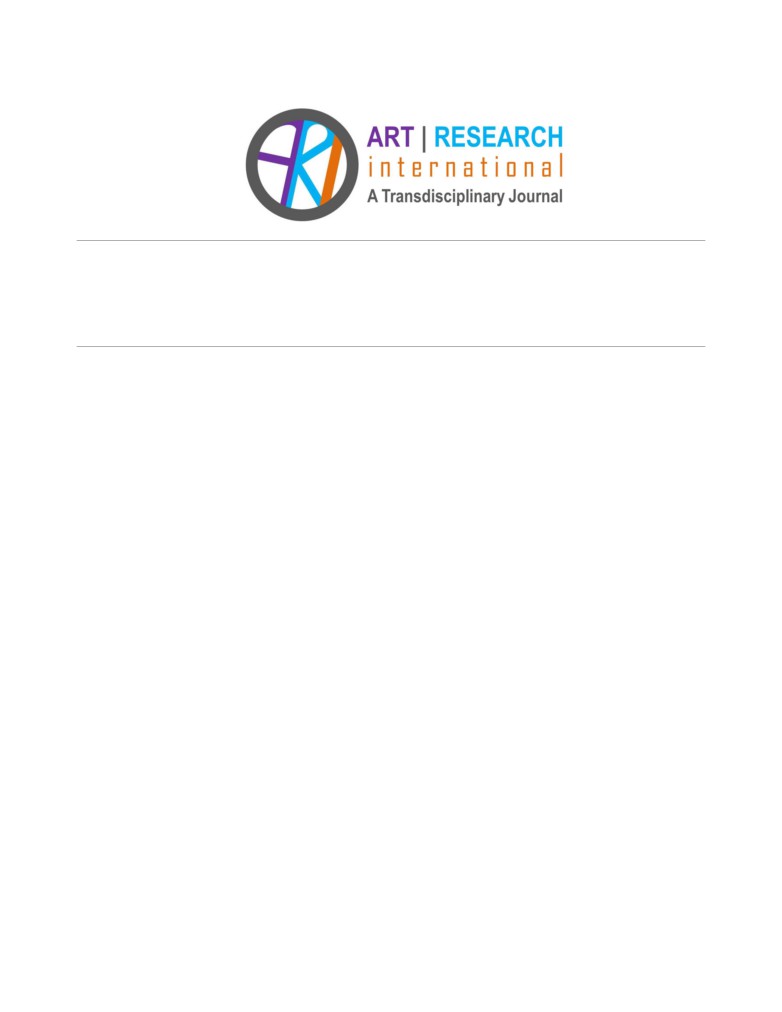Art/Research International: A Transdisciplinary Journal
Volume 4 Issue 1, 2019
EDITORIAL FOR SPECIAL ISSUE: MAKING AS METHOD:
REIMAGINING TRADITIONAL AND INDIGENOUS
NOTIONS OF “CRAFT” IN RESEARCH PRACTICE
Esther Fitzpatrick
Guest Co-editor
University of Auckland, New Zealand
Rosemary C. Reilly
Guest Co-editor
Concordia University
Esther Fitzpatrick, PhD, is a Senior Lecturer in the Faculty of Education and Social
Work at the University of Auckland, New Zealand. Throughout her doctorate, as an
autoethnographic project, Esther became increasingly interested in craft and ekphrastic
poetry as innovative methods, to make sense of complex issues for emerging identities
in postcolonial societies. She has since published broadly and has a variety of teaching
and research interests including culturally sustaining pedagogies, narrative inquiry,
critical theory and pedagogy, arts-based methods, philosophy of education, postcolonial
studies, white identity, decolonising practices, neoliberalism, and teacher identity. Esther
is particularly interested in innovative research collaborations.
Rosemary C. Reilly, PhD, CCFE, is an associate professor in the Department of
Applied Human Sciences at Concordia University in Montréal, Québec. She is also a
Member Scholar Academic of the International Institute for Qualitative Methodology. Her
Editorial
i
Art/Research International: A Transdisciplinary Journal
Volume 4 Issue 1, 2019
research interests include the impact of trauma on neighbourhoods and communities,
collective healing strategies and systemic resilience, creativity, and qualitative and arts-
based research methodologies. She also learned embroidery as a child from her
mother, knitting from her mother-in-law, and continues to explore crafting as a research
methodology and for her own well-being.
Editorial
ii
Art/Research International: A Transdisciplinary Journal
Volume 4 Issue 1, 2019
Felicia Semple (2019), a blogger who writes about the connection between hand-
making and well-being, recounted a story about an off-handed remark made by her son
when he came upon her knitting in her study. “Look at you, sitting there knitting like
some old granny.” She responded, “My love, how many granny’s [sic] do you actually
know who knit
nearly every woman you know knits, and none of them are grandmas,
so why are you perpetuating a stereotype that is not true in your world. For that matter,
where did you even get that stereotype… You are surrounded by people who knit who
are in their
30s and 40s.” Semple uses this incident as the launching point for
interrogating the notions of craft as trivial, useless, ridiculous, indulgent, privileged, and
worthy of scorn and derision.
Craft is not trivial.
For eons, human beings, most often women, have gathered together, or worked
alone, to tell their stories through crafting, whether it be with thread, fabric scraps,
beads, clay, yarn, wood, paper and leather, reeds, or other ordinary materials - the
original bricoleurs constructing beauty, meaning, and culture from whatever was at
hand, transforming everyday objects. Passed down from one generation to the next as
an embodied practice, crafting became a social process for empowerment, action, and
expression. But crafts have a deeper significance: the hierarchical classification of art
versus craft mirrors longstanding power and status differences based on gender, class,
social, and economic structures (Lippard, 2010).
Craft is not useless.
Crafting is not only a way of embodied knowing, it can represent covert action
when done in a protest or resistance context. Craftivism is a term popularized by North
Carolina activist Betsy Greer. It refers to the use of politically engaged crafting methods
as a strategy to examine and challenge contemporary issues and policies (Black &
Burisch, 2010), and has a long historical tradition. Throughout ancient Greek writings
(see The Odyssey), there are repeated instances of women weaving messages into
fabric when they were silenced, using these objects to testify to their experiences of
sexual or gender-based violence (W. N. P. Radio, 2019). Quilts made by enslaved
African women in the antebellum southern United States were a way to secretly pass on
outlawed African spirit traditions (Fry, 2002). Sojourner Truth engaged in knitting and
needlework as a form of resistance (Sophia Smith Collection, n.d.). Songs crafted by
Japanese women mill workers in the 1880s were able to sustain them during strikes for
better condition and wages (Kondo, 2009). The NAMES project AIDS quilt documented
lives that history might have neglected, and concretely illustrated the devastating impact
Editorial
iii
Art/Research International: A Transdisciplinary Journal
Volume 4 Issue 1, 2019
of the disease (Lewis & Fraser, 1996). The arpillera movement in Chile allowed ordinary
women to defy a military dictatorship by embroidering their sorrow onto scraps of
material as a means of protest and resistance, memorializing the disappeared (Agosín,
1996).
Craft is not ridiculous.
When these craft-making practices are employed in the research process, they
can provide a significant way to tap into hidden stories, stories that reside in our bodies
and in our pasts, stories that shape our current understandings and positions. In
response to increasing globalization, traditional and Indigenous craft-making practices
are being reimagined as important ways of remembering and reclaiming - of disrupting
dominant discourse and making sense of our worlds (Fitzpatrick & Bell, 2016). Crafting
requires us to listen once again to our bodies. It can allow us to tell our stories without
the constraints of the written word, and to identify differently with our social context.
When combined with research, craftivism can raise consciousness, create wider
conversations about social issues, challenge injustice, fashion tools for proactive
political protest, and find creative solutions to conflict (Baumstark et al., n.d.).
The idea for this special issue was woven from several disparate and distinct
threads.
For Esther
It began (again) one summer, when the new school year was just beginning
- a time of year when everything is still possible. I had agreed to meet with
a student who was contemplating a Masters and wanted to discuss the
possibility of supervision. I remember we sat outside the Faculty of
Education’s tent cafe at a picnic table, so her two young children could run
around on the tennis courts, and we talked seriously about culturally
responsive practice and her various education experiences. I was imagining
this shaping up to be an interesting and traditional qualitatively designed
study. Every methods textbook has formulae for this. I had also imagined
that this meeting was about to end, the kids were getting scratchy and we
had covered everything, just needed to discuss where to next. That was
when she drew my attention to a large woven bag she had sitting down at
her feet. She looked across at me and asked, “I’ve brought something with
me - could I show you?” “Sure,” I replied. Then she reached down and took
out of the bag a bundle of fabric patches, placing them gently on the large
Editorial
iv
Art/Research International: A Transdisciplinary Journal
Volume 4 Issue 1, 2019
wooden picnic table. “Do you think I could make a quilt as part of my
methodology?”
I had started noticing researchers doing wonderful things as method part
way through my doctorate. First, at the International Visual Methods
conference in Wellington in 2013, I learned about the making of arpillera in
Chile. Phiona Stanley at the 2017 Critical Autoethnography Conference in
Melbourne sat and knitted in response to participants shared voices and
created an art piece. I later sat with Hinekura Smith who taught me the
method of flax weaving.
For Rosemary, it started early.
My mother, Emma, was a first generation Italian born in the US. Historically,
Italy has had a long tradition of bright and colourful needlework. Though
embroidery is generally considered a symbol of luxury and wealth
(Quaresmini, 2015), this tradition is firmly rooted in Italian peasant culture.
Embroidery was used to celebrate their relationships with God, nature, food,
and iconic images from the pre-Christian past. During special festivals
women would wear beautiful dresses and bodices, handcrafted with detailed
embroidery (Grabianowski,
2011). Dresses, stitches, and patterns were
passed down from mothers to daughters for generations. And when I was
little, perhaps around the age of 4 or 5, she passed onto me the skill of
embroidery, though her knowledge was limited by her own mother’s death
when she was only 13. Unfortunately, in my teens, I forsook the practice. It
seemed to me at the time, foolishly so, that it was unseemly for a feminist to
engage in needlework.
When I married into my husband’s family in the 70s, I was gifted with a
knitted family afghan. Everyone in the Nerenberg family had one, each with
their own distinctive color palette. My mother-in-law, Arona, learned to knit
and sew from her mother, Lilly, who took in sewing to supplement the family
income. Arona’s first career was as a seamstress in the same clothing
factory as her father. She made clothes and altered them. She was a doll-
maker. But, later in life, her forté was knitting, and she made her distinctive
afghans for all members of the family. She taught me how to knit, though I
have an odd way of knitting. She was left-handed. I am right-handed. So I
knit like a left-hander with my right hand. In this way, she is with forever with
me.
Editorial
v
Art/Research International: A Transdisciplinary Journal
Volume 4 Issue 1, 2019
A third thread was introduced when Esther and Rosemary met at the Critical
Autoethnography conference in Melbourne in 2016. Rosemary was presenting on the
use of doll-making for interrogating and communicating data about difficult but
courageous lived experiences (Reilly, 2016), citing Esther’s work with Avril Bell on using
arpillera to speak with the ghosts of their white European colonial ancestors (Fitzpatrick
& Bell, 2016). From opposites side of the world, across a distance of 16,726 km, craft
created a connection.
Craft is not indulgent.
In this special issue of
“making as method” we aim to help shift the cultural
narrative about craft by celebrating a diverse range of creative researchers who disrupt
Western ways of knowing, celebrate a reclaiming of Indigenous knowledge and
methods, provide space for decolonising practices, and in this digital age, reimagine
traditional and Indigenous notions of craft in research. These authors all theorise their
craft and provide, in one issue, a rich and varied theoretical justification for “making as
method.” As articulated by Neil Cunningham (2017), “We are at a fascinating inflection
point, where crafts, old and modern, are intermingling, and opening many new avenues
…” (para. 7). Craft is in the process of being reimagined in a technological age.
Treadaway (2007) describes a hybrid practice, where digital techniques are combined
with textile craft skills to support and enhance creative practice. However, recognition of
the significance of “making” is consistent.
Our hands help us think and physical making provides opportunities for
serendipitous and accidental creative insights that the logic and control of
the machine can often inhibit. By combining traditional textile handcraft,
such as hand embroidery, screen printing and hand painting, digitally printed
surfaces can be embellished… (Nimkulrat, Kane, & Walton, 2016, p. 30)
Craft is not privileged.
In this issue Indigenous researchers from Canada, Australia, Hawaii, Greece,
and Aotearoa New Zealand provide thoughtful narratives, which explore and present
traditional craft making as method. Further, collaborations between Indigenous and non-
Indigenous researchers and participants through “making as method” provide ways we
might begin to work differently - together. Other research collaborations, in this special
issue, demonstrate how “making as method” can be employed to generate stories
differently, and often from overlooked voices or vulnerable participants - those who
require us as researchers to be ethically creative in our endeavours. Several other
Editorial
vi
Art/Research International: A Transdisciplinary Journal
Volume 4 Issue 1, 2019
researchers also draw on “making as method” to explore their own identity journeys and
disrupt normative assumptions.
Craft is not worthy of scorn and derision.
This issue aims to conclusively demonstrate that.
Art/Research Theoretical Musings
Indigenous Māori scholar Hinekura Smith, from Aotearoa New Zealand (Tribes:
Te Rarawa, Ngāpuhi, Te Ati Awa) (The University of Auckland), in “Whatuora: Theorizing
‘new’ Indigenous methodology from ‘old’ Indigenous weaving practice” theorises a Māori
weaving practice as a decolonising research methodology for her research (Smith,
2017). She explores the lived experiences of eight Māori mothers and grandmothers as
they wove storied Māori cloaks. Tiffany Dionne Prete, from the Blood Tribe of the
Blackfoot Confederacy,
(University of Alberta), in
“Beadworking as an Indigenous
Research Paradigm” provides three principles that form the conceptual basis of
beadworking as an Indigenous research paradigm, arguing the method as an act of
resistance. She illustrates how beading a pair of moccasins as a gift to a knowledge
holder allowed her to engage with the Blackfoot natural laws of the universe. She
argues that Indigenous research in the academy is relatively new, and should be used
as a means to decolonize her people (Smith, 1999). Katerina Konstantinou (Panteion
University of Social and Political Sciences, Greece), and Aris Anagnostopoulos
(University of Kent), in
“Interweaving contemporary art and
‘traditional’ crafts in
ethnographic research” designed a collaborative project using “traditional” crafts in an
open art-studio in a rural community at a mountain village in Crete, Greece. The open
art studio is a response to Onciul’s (2015) theorized engagement zones. Importantly,
they highlight the tensions that arise in collaborative projects and also note that the
process is not, or not only, the evocation of a historical experience, a past “already
there,” but also a meeting ground between the embodied, sensuous knowledge of the
past and our formal, social-scientific and historical methods of approaching it. Eveliina
Sumelius-Lindblom (University of the Arts, Helsinki), in “The pianist’s perception as a
working and research method: Encountering intertextual and phenomenological
approaches in piano playing” explores her role as a pianist. She defines craft as a multi-
layered entity, which is not solely confined to “making music” but includes - as an
inherent part of the craft
- conducting research as well. She argues that making
decisions in piano playing is comparable to Merleau-Ponty and Landes’ (1945/2014)
concept of the “intentionality of the body.” Founded on an epistemic perspective that
Editorial
vii
Art/Research International: A Transdisciplinary Journal
Volume 4 Issue 1, 2019
knowledge is gained through a dynamic process of experientialism (Savin-Baden &
Major, 2013).
Art/Research In Action
Indigenous scholar Una Kimokeo-Goes (Linfield College), in “The quilt speaks:
Crafting gender and cultural norms in Hawaii” demonstrates how her Hawaiian
ancestors, while adopting the colonial practice of sewing and quilt making,
simultaneously also subverted aspects of the missionary belief system. She describes
how quilting allows for her
“entanglement of matter and meaning, past and
future” (Barad, 2007, p. 383) and argues that, while her craftwork is far from traditional,
the missionary skills of sewing and quilting and her Indigenous undertones remain.
Christine Rogers (RMIT University, Melbourne), in “The needle as medium: Using
embroidery to speak to ghosts” as an adoptee, uses the practice of embroidery to
“speak to/with her Indigenous Māori ghosts.” Recently discovering her Ngāi Tahu
ancestors, through the vernacular of craft she
“represents the
unrepresentable” (Holloway & Kneale, 2008, p. 297). Rogers describes how “[a]s the
words and Māori and European motifs become three-dimensional under my fingers, no
longer computer-generated and perfect, but wonky, flawed and human, I can feel a
connection being made between me and the work, and a connection to my past.”
From Australia, Indigenous scholars Tracey Bunda, a Ngugi/Wakka Wakka
woman, (University of Southern Queensland), Robyn Heckenberg, a Wiradjuri woman,
(University of Southern Queensland), and collaboraters Kim Snepvangers
(The
University of New South Wales), Louise Gwenneth Phillips
(The University of
Queensland), Alexandra Lasczik (Southern Cross University), and Alison L Black,
(University of the Sunshine Coast) in
“Storymaking belonging” describe their
experimental making research methodology. Stitching, threading, imaging, dancing, and
painting, they argue that, “sometimes data invites more of us. To be physically held and
touched, through hands creating and crafting with matter, cultivating a closer connection
to the fibres, threads, textures and sinews of data.” Ruth Beer (Emily Carr University of
Art and Design) and Caitlin Chaisson (Emily Carr University of Art and Design) in “A
Canadian selvage: Weaving artistic research into resource politics” use a contemporary
weaving method to shed light on the present entanglement between Indigenous and
non-Indigenous cultural heritage, ecological perspectives, and resource extraction.
Through their collaboration they explore the ways fibers, land, and networks penetrate
both woven fields and resource fields, and how arts-based research can support critical
reflexivity when addressing some of these connections. Drawing on Auther (2010), they
Editorial
viii
Art/Research International: A Transdisciplinary Journal
Volume 4 Issue 1, 2019
question the motives and politics behind limited views of the relationship between art
and craft, and see craft as offering a vital and rigorous perspective on the world.
In her autoethnographic project Julie Brien (The University of Auckland), in
“Stitchery me, stitchery do” describes herself as having “always been a crafter, and a
sometimes quilt maker.” Working in collaboration with her participants to explore the
practice of culturally responsive pedagogies she defines crafted as something that is
created with care, time, diligence, skill, and technique, whereas the word mastery is
associated with skill and technique (Shiner, 2012). Learning to listen to the land and
sharing stories and poems from that listening, Margaret McKeon (University of British
Columbia), in “Patterns repeat: Transformation through creativity in research about land
and colonialism” describes her poetic “writing as her humble offering of reciprocity”.
Applying the term crafting to the creation of her own life and art making, she explores
her becoming as a descendent of white settlers on unceded Musqueam territory. She
learns to stand and dance stories, with the Indigenous people and with her ancestors.
She references Cardinal and Armstrong (1991) who speaks of “creativity as a human
responsibility or purpose of seeking through the unknown to bring forward the new.”
Creating spaces for overlooked voices or/and the vulnerable to be heard,
Corinna Peterken (Brigham Young University), through “Crafting living inquiry with a
quilt of children’s images” with young children, designed a collaborative co-creation of a
quilt as a living inquiry to provide spaces for learning and knowledge making. Corinna
worked as artist, researcher, and teacher (Springgay, Irwin, Leggo, & Gouzouasis,
2008), and describes how she used “playful experiences with our crafting to create
places where we could use quilting and the quilt to ‘dip into the spaces between
knowledges already made’ (Ellsworth, 2005, p. 142).” For six months, tapestry artist/
researcher Ilona Pappne Demecs
(Queensland University of Technology), with
researcher Evonne Miller (Queensland University of Technology), in “Woven narratives:
A craft encounter with tapestry weaving in a residential aged care facility” moved her
studio into an aged care home in Australia to conduct a participatory art project. In
collaboration with the residents they used a rare craft (tapestry weaving) that develops
at a slow pace, enabling conversations, connections, and suiting the slower pace of
older age. Kathryn Grushka
(University of Newcastle), Michelle van Gestel
(University of Newcastle), and Clare Skates, fibre artist/tapestry weaver and
researcher, collaborate together through the act of exploring their shifting identities
through a continuous folding of the artists’ own encounters with the world of
contingencies in the telling and re-telling of personal narratives through art making.
Through their “making as method” they embrace the idea that “truth is producing
Editorial
ix
Art/Research International: A Transdisciplinary Journal
Volume 4 Issue 1, 2019
existence” (Deleuze, 1990, p. 134), positioning their research in the post-qualitative
turn, wherein knowing is not privileged over being (Lather & St. Pierre, 2013).
Jessica Smartt Gullion (Texas Woman’s University), in “Pathology: A Diffractive
Encounter of Machine/Body” uses art journaling, a material discursive interface, and
created images and text while thinking about her experience of undergoing surgery and
diffracting through Haraway’s (2016) ideas about cybernetics and machine bodies.
Break apart.
“Cutting together-apart
(one move)
In the (re)configuring of spacetimemattering (Barad, 2014, p.168).
Allison Ray Reagan (Texas Woman’s University), in “Quilt/cARTography: Using
craftivism to explore food insecurity on a college campus” employs a constructivist
approach to creating learning environments by incorporating craftivism-based
instructional design techniques to engender learning through Quilt/cARTography. She
further contends that arts-based quilts provide an effective method for the dissemination
of data. Phiona Stanley (Napier University, Scotland), in “Crafting a DIY campervan
and crafting embodied, gendered identity performances in a hyper-masculine
environment” provides a visual and textual narrative describing her journey of “hanging
out with a bunch of tradies in a diesel mechanic’s workshop.” Beautifully capturing the
“gendered identity performances” while involved in a campervan conversion project
which she describes as “technical” and “physical” and may be regarded as a rather
more masculine pursuit (e.g. Bratich & Brush, 2011). Zabe MacEachren (Queen’s
University, Canada), in “Unplugged craftivism: A story of humans and environmental
education” takes us back to what she describes as the first rule of craft making -
knowing where to find the material you need to live—the stuff of life, as Indigenous
author Lee Maracle (1996) refers to it. Zabe posits that craft belongs to the story of
humans and their interaction with the environment
- and is probably the most
endangered outdoor experience in the modern world. Belinda MacGill (University of
South Australia), in “Craft, relational aesthetics and ethics of care” couples a feminist
reading of craft with Ahmed’s (2003) notion of accumulation. She argues crafting is a
powerful political weapon that resists neoliberal manifestations of being in this world.
Her practice in craft involves modifying sea balls found on the beaches in the intertidal
zones in South Australia.
Editorial
x
Art/Research International: A Transdisciplinary Journal
Volume 4 Issue 1, 2019
I walk in the stories of colonization in melancholic silence and traverse the
deep ruptures that only the earth can heal and in so doing the Sea craft
Balls act as a way to sew myself back into a place of relationality where the
assemblages work metaphorically; signifying the possibilities of
postcolonialism.
Art/Research Reviews
For the review section we invited five arts-based researchers to each write an
ekphrastic review for one of the “making as method” articles presented in this special
issue. We believed crafting poetic reviews captured the essence of the issue, and the
submissions. As Faulkner (2017) reminds us when writing research poetry
many arts-based researchers are also poets making us poet-researchers,
research-poets, or simply poets who do and use research in our poetic
work. The similarities reside in the use of process-oriented craft to explore
reality, create something new, disrupt usual ways of thinking and create
embodied experience. (pp. 213-214)
These ekphrastic works involve a poetic response to an aesthetic form through
interpretive practices (Kulnieks & Young, 2014; Maddison-MacFayden, 2013). This form
of ekphrasis (where one art form is used to respond to another art form to reveal,
communicate and illuminate the message) is a form of poetic inquiry that is consistent
with Prendergast’s (2004) definition - a method to “draw out or make clear” (p. 3) the
practice of creating art in response to art. Ekphrasis can be used as an interplay
between visual, textual, and performative works (see Fitzpatrick, 2015).
Prendergast (2004) highlights five important categories from Bruhn (2000) on the
use of ekphrasis in inquiry. First, the potential for ekphrasis to recreate through other art
forms a response to an original art work (transposition). Second, the potential for
ekphrasis to add non-spatial, for example, sensory, dimensions
(supplementation).
Third, it provides a stimulus to trigger memories (association). Fourth, it provides the
researcher with a critical eye (interpretation). Finally, ekphrasis has the potential for
playfulness in the crafting of the new art work.
The ekphrastic reviews, a series of poems, are in the same order as their
associated “making as method” articles in the journal. Fetaui Iosefo (The University of
Auckland), in “Settling the soul through va” responds to Hinekura Smith’s weaving of
Māori cloaks. Sandra Faulkner (Bowling Green State University), in “Pākehā sampler”
Editorial
xi
Art/Research International: A Transdisciplinary Journal
Volume 4 Issue 1, 2019
responds to Christine Roger’s embroidery to speak to ghosts. Adrian Schoone
(Auckland University of Technology), provides “An ekprhastic review of Ilona Pappene
Demes and Evonne Miller’s tapestry weaving” in a care home. James Burford (La
Trobe Univerisity), writes “An ekphrastic poem for Phiona Stanley” and her gendered
identity performance of her campervan conversion project. Rosemary Reilly
(Concordia University, Canada), entangles her own story through an ekphrastic review
of Belinda MacGill’s Sea Craft Ball’s in “Entanglements across time-space.”
Editorial
xii
Art/Research International: A Transdisciplinary Journal
Volume 4 Issue 1, 2019
REFERENCES
Ahmed, S. (2003). Affective economies. Social Text, 22(2), 117-139.
Agosín, M. (1996). Tapestries of hope, threads of love: The arpillera movement in
Chile 1974-1994. Albuquerque, NM: University of New Mexico Press.
Auther, E. (2010). String, felt, thread: The hierarchy of art and craft in American art.
Barad, K. (2007). Meeting the universe halfway: Quantum physics and the
entanglement of matter and meaning. Durham, NC: Duke University Press.
Barad, K. (2014). Diffracting diffraction: Cutting together-apart. Parallax, 20(3),
168-187. DOI:10.1080/13534645.2014.927623
Baumstark, M. C., Carpenter, E., Davies, J., Gooderham, T., Greer, B., Harvey, B.,
Marsh, R., Marvel, M., Miller, A., Nectar, I., Nielsen, A., Poppelin, E., & Varvis,
Black, A., & Burisch, N. (2010). Craft hard, die free: Radical curatorial strategies for
craftivism in unruly contexts. In G. Adamson (Ed.), The craft reader (pp.
609-619). New York, NY: Berg.
Bratich, J. Z., & Brush, H. M. (2011). Fabricating activism: Craft-work, popular
culture, gender. Utopian Studies, 22(2), 233-260.
Bruhn, S. (2000). Musical ekphrasis: Composers responding to poetry and painting.
Hillsdale, NY: Pendragon Press.
Cardinal, D., & Armstrong, J. C. (1991). The Native creative process: A collaborative
discourse between Douglas Cardinal and Jeannette Armstrong. Penticton, B.C:
Theytus.
Cunningham, N. (2016, January, 23). The reimagining of craft in a technological age.
Editorial
xiii
Art/Research International: A Transdisciplinary Journal
Volume 4 Issue 1, 2019
Deleuze, G. (1990). Negotiations, 1972-1990. (M. Joughin, Trans.). New York, NY:
Columbia University Press.
Ellsworth, E. (2005). Places of learning: Media, architecture, pedagogy. New
York, NY: Routledge.
Faulkner, S.L. (2017). Poetic inquiry: Poetry as/in/for social research. In P. Leavy
(Ed.), Handbook of arts-based research (pp. 208-230). New York, NY: The
Guildford Press.
Fitzpatrick, E. (2015). It's a tricky business: Performing poetry with the ghost. In P.
O'Connor & M. Anderson (Eds.), Applied theatre research: Radical departures
(pp. 207-225). London, UK: Bloomsbury Methuen Drama.
Fitzpatrick, E., & Bell, A. (2016). Summoning up the ghost with needle and thread.
Departures in Critical Qualitative Research, 5(2), 1-24. DOI:10.1525/dcqr.
2016.5.2.1.
Fry, G.-M. (2002). Stitched from the soul: Slave quilts from the antebellum South.
Chapel Hill, NC: University of North Carolina Press.
Grabianowski, E. (2011, July 25). How Italian traditions work: Traditional Italian
Haraway, D. J. (2016). Manifestly Haraway. Minneapolis, MN: University of
Minnesota Press.
Holloway, J., & Kneale, J. (2008). Locating haunting: Ghost-hunter's guide. Cultural
Geographies, 15(3), 297-312. DOI:10.1177/1474474008091329
Kondo, D. (2009). Crafting selves: Power, gender, and discourses of identity in a
Japanese workplace. Chicago, IL: University of Chicago Press.
Kulnieks, A., & Young, K. (2014). Ekphrastic poetics: Fostering a curriculum of
ecological awareness through poetic inquiry. in education, 20(2), 78-89.
Lather, P., & St. Pierre, E. (2013). Post-qualitative research. International Journal of
Qualitative Studies in Education, 26(6), 629-633. DOI:
10.1080/09518398.2013.788752
Editorial
xiv
Art/Research International: A Transdisciplinary Journal
Volume 4 Issue 1, 2019
Lewis, J., & Fraser, M. R. (1996). Patches of grief and rage: Visitor responses to the
names project AIDS memorial quilt. Qualitative Sociology, 19(4), 433-451.
Lippard, L. (2010). Making something from nothing: Toward a definition of women’s
“hobby art.” In G. Adamson (Ed.), The craft reader (pp. 483-490). New York,
NY: Berg.
Maddison-MacFayden, M. (2013). This white woman has journeyed far: Serendipity,
counter-stories, hauntings, and ekphrasis as a type of poetic inquiry. Morning
Watch Journal of Educational and Social Analysis [Special Edition]. Narratives
of becoming a researcher, 40, 1-15.
Maracle, L. (1996). I am woman: Native perspective on ecology and feminism.
Vancouver, BC: Press Gang Publishers.
Merleau-Ponty, M., & Landes, D. A. (2014). Phenomenology of perception. Abingdon
Oxon, UK: Routledge. (Original work published in 1945)
Nimkulrat, N., Kane, F., & Walton, K. (2016). Crafting textiles in the digital age.
London, UK: Bloomsbury.
Onciul, B. (2015). Museums, heritage and Indigenous voice: Decolonizing
engagement. New York, NY: Routledge.
Prendergast, M. (2004, July). Ekphrasis and inquiry: Artful writing on arts-based
topics in educational research. Paper presented at the meeting of the Second
International Imagination in Education Research Group Conference, Simon
Fraser University, Vancouver, British Columbia, Canada. Retrieved from http://
Quaresmini, L. (2015, December 1). A fashion history: An introduction to the history
Reilly, R. C. (2016, July). Reclaiming my sister Medusa: A critical autoethnography
about calling out and reporting sexual violence. Paper presentation at the
Critical Autoethnography Conference 2016, Melbourne, Australia.
Savin-Baden, M., & Major, C. H. (2013). Qualitative research: The essential guide to
theory and practice. New York: Routledge.
Editorial
xv
Art/Research International: A Transdisciplinary Journal
Volume 4 Issue 1, 2019
Semple, F. (2019, January 4). Craft is not trivial [Web log post] Retrieved from http://
Shiner, L. (2012). ‘‘Blurred boundaries’’? Rethinking the concept of craft and its
relation to art and design. Philosophy Compass, 7(4), 230-244. DOI:10.1111/j.
1747-9991.2012.00479.x
Smith, H. L. (2017). Whatuora: Whatu kākahu and living as Māori women.
(Unpublished doctoral dissertation). University of Auckland, Auckland, NZ.
Smith, L. T. (1999). Decolonizing methodologies: Research and Indigenous peoples.
Dundein, NZ: University of Otago Press.
Springgay, S., Irwin, R. L., Leggo, C., & Gouzouasis, P. (Eds.). (2008). Being with
a/r/tography. Rotterdam, NL: Sense Publishers.
Sophia Smith Collection. (n.d.). Sojourner Truth seated with knitting. Retrieved from
Treadaway, C. (2007). Digital crafting and crafting the digital. The Design Journal,
10(2), 35-48. DOI:10:2, 35-48. 10.2752/146069207789272668
W. N. P. Radio (Producer). (2019, January 4). Knitting as protest [Audio podcast].
Editorial
xvi















